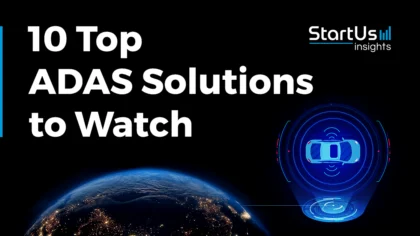Integrating artificial intelligence (AI) in the automotive industry enables manufacturers and service providers to streamline operations and reduce costs. The global automotive AI market is projected to reach USD 48.59 billion by 2034, with a CAGR of 29.61% from 2025 to 2034. The United States leads this sector with a projected worth of around USD 7.68 billion by 2034.
In this strategic guide, we explore 10 key areas where AI is transforming the automotive industry. Gain practical insights, discover popular automotive AI applications, and learn about emerging companies to stay ahead in this evolving landscape.
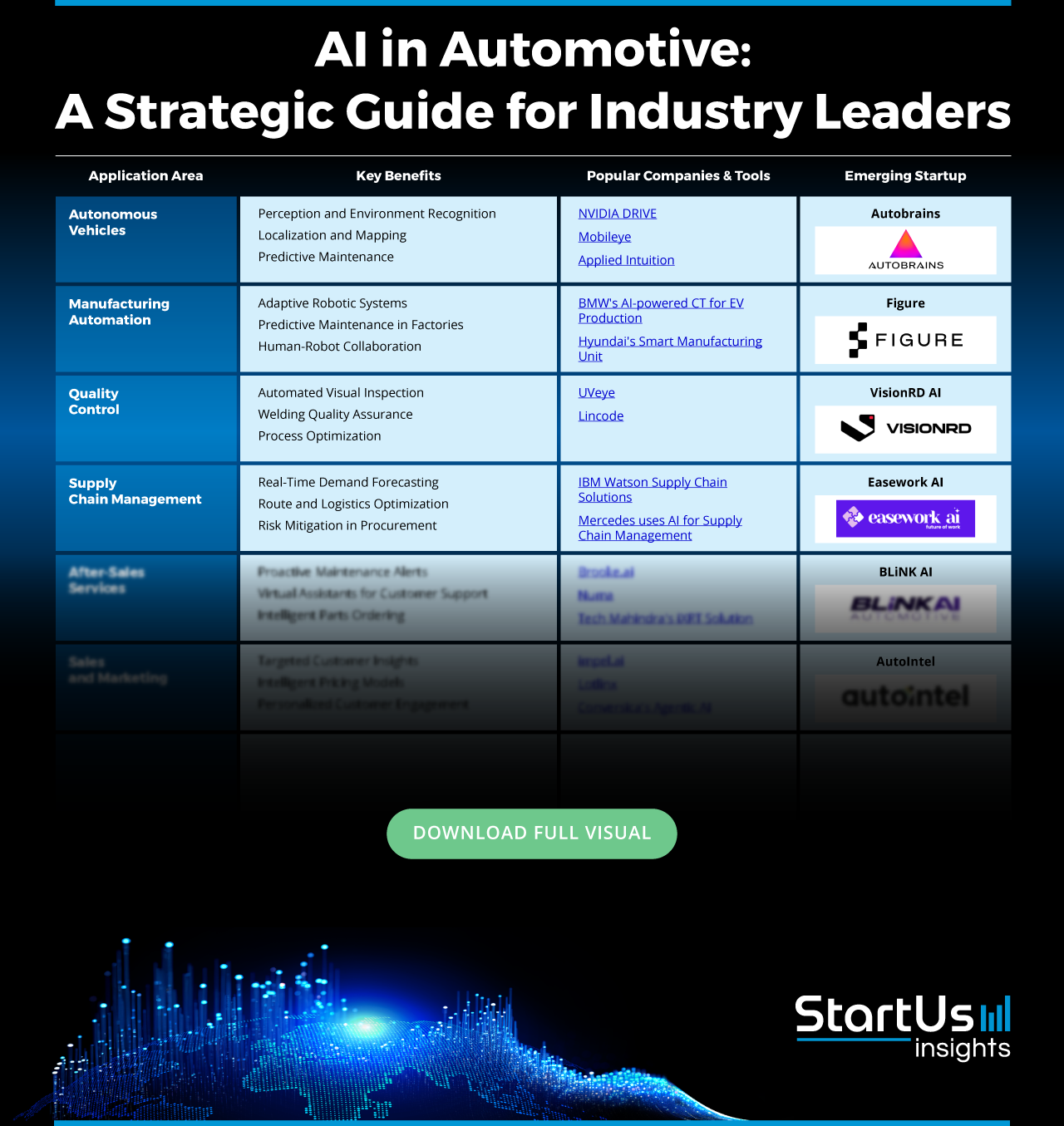
Key Takeaways
- Outlook on the Adoption and Economic Impact of AI: AI adoption in the automotive industry is accelerating across functions and stakeholders for significant cost savings and revenue boosts.
- 10 Key Areas Where AI is Transforming Automotive Industry
- Key Drivers: AI is becoming a necessity in automotive as innovations in other technologies drive its integration, alongside EV growth, autonomous driving, market competition, and manufacturing efficiencies.
- Future Outlook of AI in Automotive: The future of automotive will be driven by emotion-responsive systems, multimodal AI, and AI-powered vehicle-to-everything (V2X) communication.
How Do We Research and Where is This Data From?
We reviewed 3100+ industry innovation reports to extract key insights and construct a comprehensive guide for integrating AI in the automotive industry. To increase accuracy, we cross-validated this information with external industry sources.
Additionally, we leveraged the StartUs Insights Discovery Platform – an AI and Big Data-powered innovation intelligence tool covering over 5 million startups and more than 20K technologies & trends worldwide to:
- Confirm our findings using the Trend Intelligence feature.
- Gather market statistics for each technology.
- Identify startups for the “Spotlighting an Innovator” sections.
Current Outlook on the Adoption and Economic Impact of AI in Automotive
Adoption Rates and Technology Adoption Curve
- Adoption Trends: Last year, 54 million cars were recorded on roads with some level of automation, up from 31 million in 2019.
- Stakeholder-Specific Adoption: 75% of automotive companies are experimenting with generative AI, while the remaining 25% plan to adopt it within a year.
- Functionality Adoption: Key areas of AI adoption include autonomous driving, predictive vehicle maintenance, smart manufacturing, and personalized in-car experiences.
Financial Metrics and Cost Effectiveness
- Market Size: The global automotive AI market size is anticipated to be USD 7 billion by 2027 with a CAGR of 24.1%.

Source: MarketsandMarkets
- Budget Impacts: In car dealerships, 81% of respondents in a survey anticipate an increase in their AI budget for 2025 compared to 2024, with 18% of dealers expecting an increase of more than 25%.
Key Factors Set to Influence Dealership Success in 2025
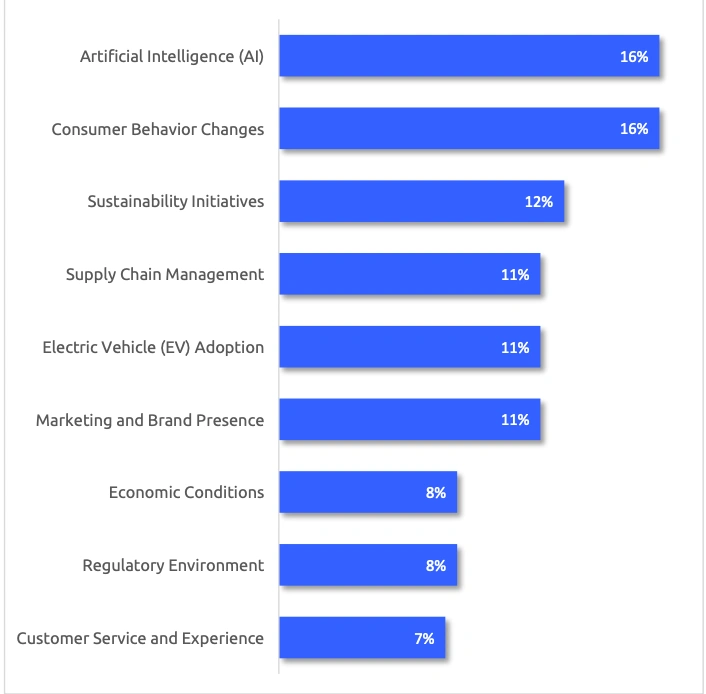
Source: Fullpath
- Cost Effectiveness: AI-driven transformations in the automotive industry have reduced cost reductions by 8% to 12% compared to baseline figures, with potential returns on investment of 10 to 15 times in less than three years.
- Indirect Economic Effects: AI solutions in dealerships have contributed to significant revenue growth, with 37% of respondents reporting a revenue increase of 20-30% and 18% experiencing growth of over 30%.
10 Areas to Implement AI in Automotive Companies [2025 & Beyond]
1. Autonomous Vehicles
AI-driven systems significantly reduce human errors and traffic accidents. For instance, Waymo’s AI-integrated autonomous vehicles have demonstrated an 85% reduction in crash-related injuries compared to human drivers. With more than 7 million miles driven, only three accidents resulted in injury in Waymo’s vehicles.
Advanced driver-assistance systems (ADAS), powered by AI, further contribute to safety through adaptive cruise control, lane-keeping assistance, and automated emergency braking. A study found forward collision warning and automatic braking systems reduce rear-end collisions.
AV also improves fuel efficiency and reduces emissions. For example, CreateAI’s autonomous trucks showed a reduction in fuel consumption by 10% to 20%, with larger reductions occurring in areas with higher traffic.
The global AV market is anticipated to reach USD 13.6 trillion by 2030 with a CAGR of 32.2%. AI optimizes traffic flow through platooning and efficient routing. This leads to reduced congestion.
Key Benefits
- Perception and Environment Recognition – AI-driven sensor fusion integrates data from LiDAR, cameras, and radar to enable real-time object detection and pedestrian tracking.
- Localization and Mapping – Simultaneous localization and mapping (SLAM) utilizes AI to dynamically update HD maps. This ensures precise positioning in complex urban environments and improves navigation in GPS-denied areas.
- Predictive Maintenance – AI algorithms analyze vehicle telemetry to detect early signs of component wear and potential failures. This reduces unexpected breakdowns and extends vehicle lifespan.
Popular Companies and Tools
NVIDIA DRIVE
NVIDIA’s DRIVE platform offers a comprehensive AI computing solution that accelerates AV development. It facilitates real-time sensor data processing and enables vehicles to perceive and navigate complex environments safely. The platform’s scalability allows it to support a range of autonomous functionalities, from driver assistance systems to full self-driving.
Mobileye
Mobileye specializes in vision-based driver-assistance systems. Its technology utilizes artificial intelligence to mimic human visual perception to identify real-time potential hazards and alert drivers. Mobileye improves vehicle safety through pedestrian collision warnings, forward collision warnings, lane departure warnings, headway monitoring, and speed limit indications.
Applied Intuition
Applied Intuition provides an AI-powered development platform tailored for ADAS and autonomous driving (AD) systems. Its toolchain spans the entire development cycle and offers simulation, data exploration, and validation solutions. The company enables large-scale virtual testing and efficient data management to accelerate autonomous vehicle technology development and deployment.
Spotlighting an Innovator: Autobrains
Autobrains is an Israeli startup that develops liquid AI technology for autonomous vehicles. This self-learning AI mimics human cognition by clustering sensory data into hyperdimensional sparse binary representations. Consequently, it enables adaptive and modular perception.
The technology addresses edge cases and reduces computational demands through scenario-based networks. By offering scalable solutions from advanced driver-assistance systems to full autonomy, Autobrains enhances road safety and makes autonomous driving more accessible.
2. Manufacturing Automation
Automotive companies utilize AI-driven automation to improve efficiency. For example, BMW’s Regensburg plant has optimized assembly line operations by implementing AI into manufacturing. This reduced disruptions and maintained optimal vehicle production flow.
AI-powered manufacturing further improves product quality through visual inspection systems that detect microscopic defects in components. It also enables predictive maintenance to reduce unplanned downtime.
General Motors collaborated with NVIDIA to develop next-generation vehicles, factories, and robotics using AI simulation and accelerated computing. The company uses predictive analytics to identify potential equipment failures and address maintenance needs.
Further, AI-enabled cobots are deployed in manufacturing workflows. They dynamically adapt to the plant environment to perform tasks like welding and painting. Tesla’s intelligent robots have achieved increased productivity through automation.
Key Benefits
- Adaptive Robotic Systems – Adjusts operations in real time to variations in materials, product designs, and assembly processes and enables mass customization.
- Predictive Maintenance – AI-driven analytics monitor equipment health to detect anomalies and predict failures before they occur.
- Human-Robot Collaboration – Cobots leverage AI for advanced perception and decision-making. This creates a safe and efficient interaction with human workers and reduces workplace injuries.
Popular Companies and Tools
BMW’s AI-Powered Computer Tomography (CT) for EV Production
BMW utilized AI-driven CT in vehicle development and production. This involved performing detailed, non-destructive inspections of vehicle components, particularly in electric vehicle engine housings. It also enables real-time quality feedback on the production line. AI integrated in CT scanning improves the precision of prototype analysis.
Hyundai’s Smart Automobile Manufacturing Unit
Hyundai Motor India converted its Sriperumbudur plant into an advanced manufacturing unit by integrating artificial intelligence, machine learning, and virtual reality (VR) technologies. This digital transformation has led to a 5% reduction in maintenance downtime and a 1% improvement in process quality. The plant utilizes over 1000 intelligent sensors and generates 12 billion data points annually to predict equipment abnormalities.
Spotlighting an Innovator: Figure
Figure is a US-based AI robotics company that develops a general-purpose humanoid robot, Figure 02. This humanoid is 5 feet 6 inches tall, weighs 70 kilograms, and operates long hours on a single charge. It navigates human environments using advanced AI and performs tasks such as lifting objects, climbing stairs, and operating tools.
The humanoid’s human-like form factor includes dexterous hands and limbs useful for seamless integration into existing workflows. During a two-week pilot at BMW’s South Carolina plant, the robot successfully fitted sheet metal parts into precise fittings for car chassis assembly. Figure 02 also ensures workplace safety by taking over hazardous duties.
Figure AI is negotiating a USD 1.5 billion funding round, led by Parkway Venture Capital, that would value the company at USD 39.5 billion.
3. Quality Control
AI-powered computer vision systems automate defect detection with precision. For instance, Audi utilizes AI-driven visual inspection systems to improve the quality of welded joints during vehicle assembly. These systems along with detecting imperfections also provide real-time feedback.
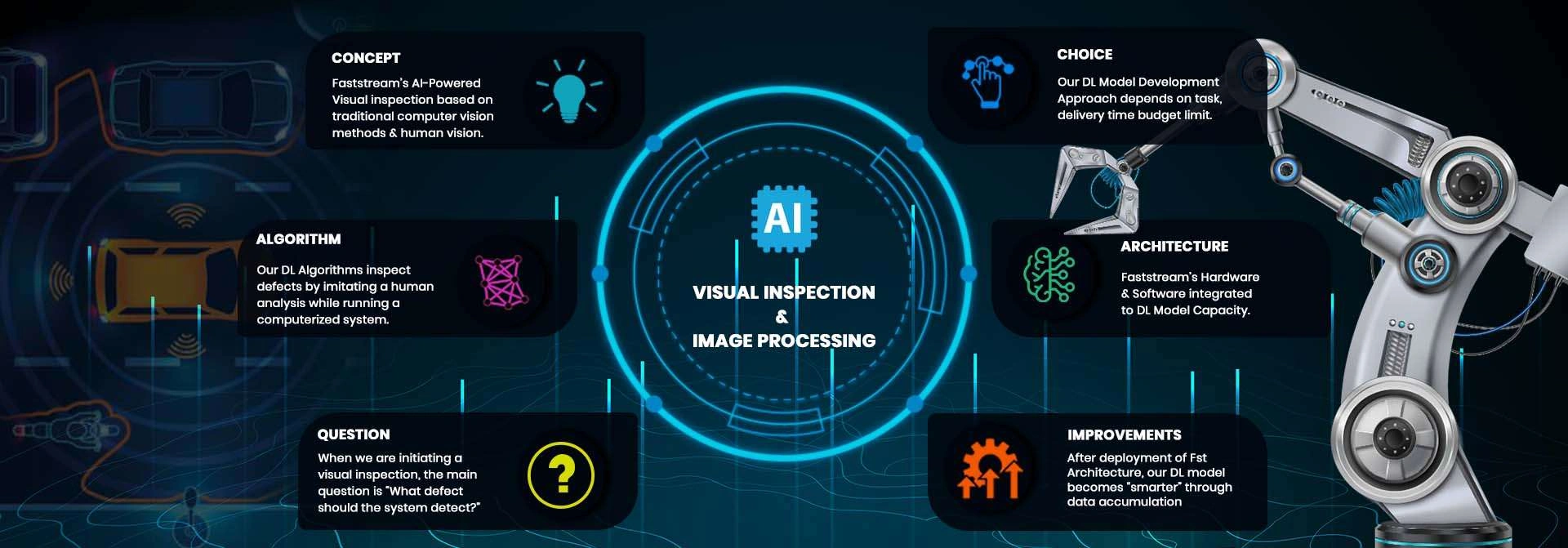
Source: Faststream Technologies
Automakers implementing AI for predictive maintenance and quality control have reduced up to 30% downtime and improved vehicle reliability.
Key Benefits
- Automated Visual Inspection – Integrating with computer vision enables the detection of surface defects, dimensional deviations, and assembly inconsistencies in real time. This accelerates defect resolution in automotive manufacturing.
- Welding Quality Assurance – The technology analyzes welding parameters, detects inconsistencies, and predicts weak joints to ensure structural integrity.
- Process Optimization – AI continuously analyzes production data, identifies inefficiencies, and optimizes workflows to reduce material waste and improve throughput.
Popular Companies and Tools
UVeye
UVeye automates vehicle inspection systems utilizing artificial intelligence and high-resolution imaging to scan vehicles quickly. Its technology detects fluid leaks, dents, and defects as small as 0.08 inches. This capability accelerates the quality assurance process and ensures a higher precision than manual inspections.
Lincode
Lincode offers an AI-powered visual inspection platform to automate quality control in manufacturing environments. Its proprietary product, Lincode Intelligent Visual Inspection System (LIVIS), combines computer vision and deep learning algorithms to detect defects, verify assemblies, and ensure data traceability. LIVIS enables real-time analysis while reducing false call rates to less than four in one million parts inspected.
Spotlighting an Innovator: VisionRD AI
VisionRD is a Pakistani startup that develops inspection AI to automate quality control in manufacturing. It uses industrial cameras and artificial intelligence to inspect products in real time. By analyzing visual data, the AI detects anomalies like incorrect or missing components. This reduces human errors and worker fatigue while ensuring product quality.
4. Supply Chain Management
AI algorithms analyze market trends and consumer behavior to predict demand for vehicles and components. This enables manufacturers to optimize production schedules and minimize storage costs. For instance, AI-driven demand forecasting has led to a 35% reduction in inventory levels among early adopters.
AI supports logistics operations by identifying the most efficient transportation routes and ensuring timely delivery of parts and vehicles. AI-driven logistics planning has resulted in a 15% improvement in logistics costs for early adopters.
For instance, Tesla employed AI to optimize demand forecasting and dynamically adjust manufacturing schedules. Its AI-powered inventory management system further streamlines warehouse storage and minimizes production slowdowns by maintaining critical component availability.
Integrating AI also allows automakers to identify potential risks like financial instability or delivery delays. This enables manufacturers to mitigate risks proactively. Moreover, AI-driven supplier risk assessment has improved service levels by 65% for early adopters.
Key Benefits
- Real-Time Demand Forecasting – Predictive analytics solutions forecast demand fluctuations to optimize inventory management, reduce stockouts, and minimize excess inventory costs.
- Route and Logistics Optimization – AI analyzes traffic patterns, weather conditions, and fleet data to optimize transport routes and improve delivery speed.
- Procurement Risk Mitigation – AI assesses supplier reliability, geopolitical risks, and market volatility in real time to prevent disruptions and optimize sourcing strategies.
Popular Companies and Tools
IBM Watson Supply Chain
IBM’s Watson supply chain leverages artificial intelligence to process and correlate vast amounts of structured and unstructured data. It enables real-time visibility and transparency across the supply chain, as well as senses and responds to demand fluctuations as they occur. The platform’s natural language processing (NLP) capabilities allow users to query data intuitively. These features collectively contribute to more agile and resilient supply chain operations.
Mercedes-Benz’s AI Integration in Supply Chain Management
Mercedes-Benz integrated AI and data analytics into the production process to optimize workflows. Automated guided vehicles (AGVs), powered by real-time data and sensors, transport materials between workstations. Moreover, an AI-driven predictive maintenance solution monitors machinery health and anticipates failures before they occur.
Spotlighting an Innovator: Easework AI
Easework AI is a Canadian company that builds an AI-powered platform to enhance procurement and supply chain operations. This platform securely integrates with existing enterprise resource planning (ERP) and software-as-a-system (SaaS) solutions to extract strategic insights and automate operational and tactical tasks using NLP.
By gaining real-time access to disparate knowledge bases, automotive companies implement informed spending decisions and risk mitigation strategies. Automakers also optimize components and materials sourcing to ensure cost-effective manufacturing.
5. After-Sales Services
Automotive companies enhance after-sales services by integrating AI technologies, such as diagnostic systems that identify vehicle issues for quicker repairs and reduced downtime. Leveraging NLP and deep learning models, AI further improves the accuracy of service request validations by over 18%.
Moreover, dealerships implementing predictive marketing strategies have observed a 30% increase in post-sale and accessory sales. For example, EvenFlow analyzes factors, like parts availability and peak demand times, to optimize repair schedules.
AI-powered diagnostic tools also accelerate vehicle issue identification for faster and more accurate repairs. Further, AI-driven chatbots and virtual assistants answer customer inquiries and schedule service appointments.
Key Benefits
- Proactive Maintenance Alerts – AI analyzes vehicle sensor data to predict potential failures and send real-time maintenance alerts to drivers.
- Virtual Assistants for Customer Support – Provide instant troubleshooting, service scheduling, and personalized recommendations to reduce service center workload.
- Intelligent Parts Ordering – Automates inventory tracking and demand forecasting for spare parts to ensure timely restocking and minimize service delays.
Popular Companies and Tools
Brooke.ai
Brooke.ai offers an intelligent conversational digital voice assistant (DVA) to handle inbound service calls for automotive dealerships. It answers frequently asked questions (FAQs) and schedules service appointments based on customer needs and dealership policies. Brooke.ai improves customer satisfaction and reduces the workload on service staff by operating 24/7. It also minimizes missed calls and manages outbound recall campaigns.
Numa
Numa provides an AI Agent platform for dealerships. It automates scheduling and delivers comprehensive communication visibility. The platform ensures that every customer call is answered to increase the booking repair orders (ROs) and scale customer demand without additional staff. Numa’s AI agents also detect customer intent, schedule appointments, and send automated status updates.
Tech Mahindra’s iXRT Solution
Tech Mahindra’s intelligent extended reality tracing (iXRT) solution leverages generative AI to enhance the automotive after-sales service experience. It provides real-time guidance and interactive circuit schematics for quicker and more accurate vehicle diagnostics and troubleshooting. This AR-powered solution facilitates multi-user engagement with voice chat to create a virtual engineering workspace. It incorporates virtual knowledge assistance that leverages generative AI and a cognitive search engine to access interactive schematic visuals.
Spotlighting an Innovator: BLiNK AI
BLiNK AI is a US-based company that develops artificial intelligence solutions to enhance automotive dealership service departments. Its automated web scheduler allows guests to book service appointments. Intelligent phone automation handles maximum call volume to guide customers through scheduling via touch-tone systems and following up with text messages.
Additionally, the service score feature sends immediate post-service surveys to capture real-time feedback and address issues promptly. By implementing these AI-driven tools, BLiNK AI streamlines profitability for automotive dealerships.
6. Sales and marketing
Automotive companies employ artificial intelligence to enable personalization in automotive marketing. It creates targeted marketing campaigns for individual preferences.
Harley-Davidson utilizes an AI-driven marketing platform, Albert, to analyze customer data. The platform autonomously analyzes audience data, optimizes creative elements, and manages cross-channel campaigns in real-time to improve marketing efficiency.
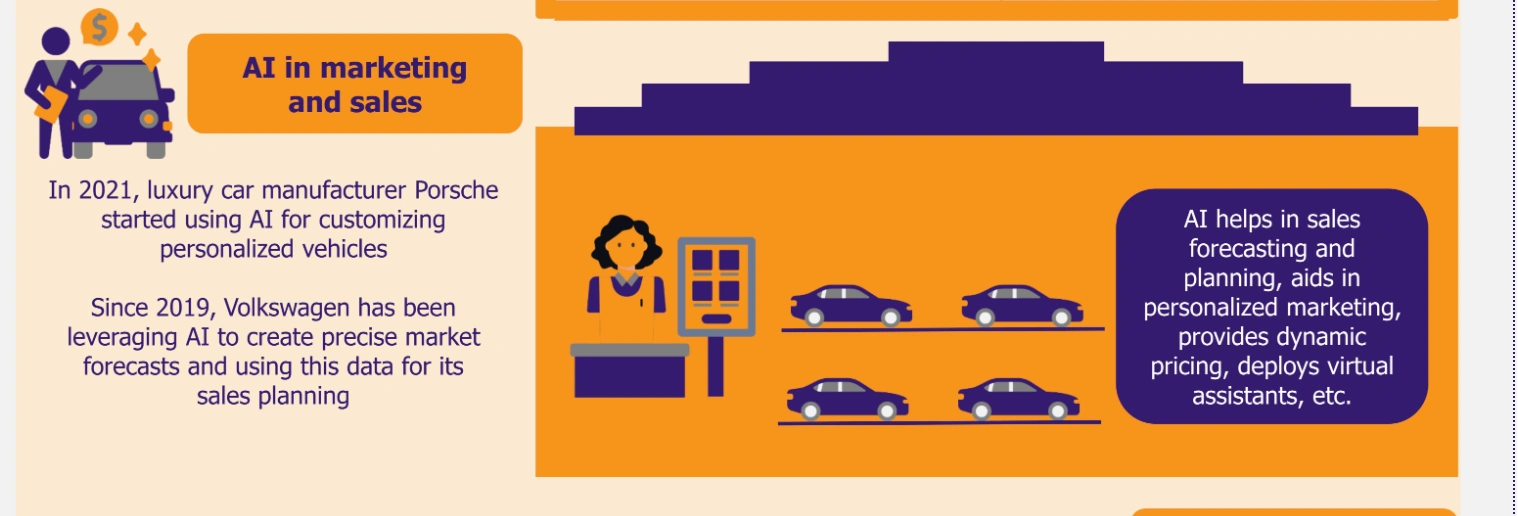
Source: EOS Intelligence
Automotive companies leverage data insights for better customer targeting and improve brand awareness. For example, Quantzig implemented a marketing decision engine for a leading US-based automotive giant to increase stakeholder engagement by 60% and customer acquisition by 15%.
Dealerships employ predictive analytics to create targeted ads that increase sales efficiency with better ROI. Moreover, AI is used in marketplace platforms to evaluate car value and increase sales. Motorway integrated AI into its valuation algorithm to provide accurate vehicle pricing. This contributed to significant annual sales growth of 141.44% over three years with revenues reaching GBP 60.9 million in 2023.
Key Benefits
- Targeted Customer Insights – AI analyzes consumer behavior, purchase history, and market trends to identify high-value customers. This improves lead conversion and customer retention.
- Intelligent Pricing Models – Dynamic pricing algorithms adjust vehicle prices based on demand, competitor analysis, and economic factors. This provides competitive pricing for different market segments.
- Personalized Customer Engagement – Recommendation engines deliver customized offers, promotions, and content through digital channels to increase brand loyalty.
Popular Companies and Tools
Impel.ai
Impel.ai offers an AI-powered customer lifecycle management platform to personalize customer engagement. Its Sales AI Copilot utilizes generative conversational AI to provide immediate, human-like responses to customer inquiries. This tool schedules showroom appointments and also intelligently handles trade-in and financing questions. By integrating with existing customer relationship management (CRM) systems, Impel.ai’s solutions enable dealerships to deliver consistent and personalized customer experiences.
Lotlinx
Lotlinx provides an AI-driven inventory management platform to optimize dealership profitability and inventory turnover. It tracks real-time data on inventory, consumer behavior, and market demand to predict risk and recommend corrective actions. Lotlinx ensures each vehicle receives targeted marketing attention and avoids unnecessary markdowns. The platform’s machine-learning capabilities offer precise pricing strategies and effective procurement decisions by aligning inventory levels with current market trends.
Conversica’s Agentic AI
Conversica’s Agentic AI features AnswersIQ for Auto to enhance customer engagement in automotive dealerships. This AI agent provides real-time inventory data for prospective buyers to receive accurate information about vehicle availability, features, and pricing. Conversica’s AI ensures instant responses to inquiries through chats, emails, and text, and reduces communication delays.
Spotlighting an Innovator: AutoIntel
AutoIntel is a US-based startup that builds software solutions to enhance user engagement and boost lead conversion in the automotive industry. Its recommender system analyzes user insights and inventory data to provide targeted vehicle recommendations, customizable configurations, and precise inventory matching.
Additionally, the intelligent co-pilot, Whiz, facilitates real-time dialogues between prospective buyers and product experts. It leverages behavioral analysis and data science to simplify the digital retail journey.
Further, the company’s product configurator offers a flexible rule validation engine through API endpoints to tailor products and locate relevant inventory. AutoIntel converts prospects into buyers and identifies upselling opportunities throughout the customer journey.
7. Insurance Risk Assessment
AI increases claims processing efficiency by reducing 60% of the operational time for insurers. The global AI market in the auto insurance industry is projected to reach USD 5.93 billion by 2034 with a CAGR of 15.10%.
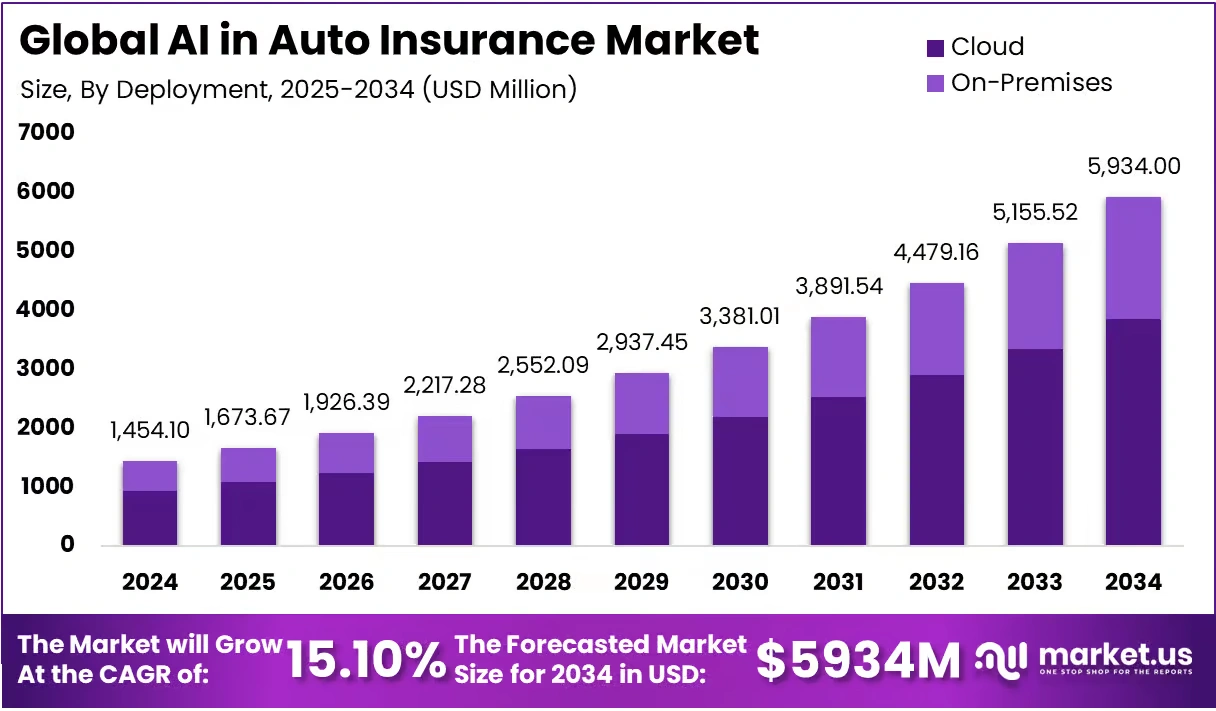
Source: Market.US
Artificial intelligence enables real-time adjustments to premiums based on actual driving conditions and behaviors. Also, it drives risk assessments to minimize precision errors based on premium calculations that reduce unnecessary payouts. For example, HDFC ERGO utilizes AI and telematics to set pricing based on real-time driving behaviors.
Insurers employ Gen AI models for risk profiling, which includes assessing driver behaviors, vehicle conditions, and automobile safety features. This enables insurers to accurately evaluate client risks and set precise premiums.
Key Benefits
- Usage-Based Policy Adjustments – AI analyzes real-time driving behavior like speed, braking patterns, and mileage. It enables insurers to offer personalized premiums, reward safe drivers, and optimize risk assessments.
- Fraud Detection – AI identifies anomalies by scanning claims data to identify inconsistencies and flag potential fraud attempts to reduce financial losses.
- Accident Severity Prediction – Algorithms assess crash data, vehicle damage, and sensor inputs to predict injury severity and enhance road safety analytics.
Popular Companies and Tools
Inspektlabs’ AI-powered Automotive Inspections
Inspektlabs leverages artificial intelligence to automate vehicle inspections. It offers a swift and accurate alternative to traditional physical assessments. By analyzing photos and videos, its technology detects 21 types of damage across various vehicle components such as plastic, fiber, glass, and rubber parts. This streamlines the inspection process and reduces time and costs for automotive companies.
Spotlighting an Innovator: Tractable
Tractable is a UK-based startup that develops artificial intelligence solutions for insurance risk assessment. Its technology utilizes computer vision and machine learning to analyze images of vehicle damage for rapid and accurate damage appraisals.
Policyholders submit photos through a web-based app, which the AI assesses to generate repair estimates. By automating vehicle damage detection and assessment, Tractable reduces claim cycle times and enhances operational efficiency for insurers.
8. Vehicle and OT security
Modern vehicles are equipped with numerous electronic control units (ECUs) and connected devices. However, this increases the attack surface and potential vulnerabilities to cyber threats. AI-driven intrusion detection systems also monitor and analyze in-vehicle network communications and identify anomalies indicative of cyberattacks.
Also, large-scale cyber incidents in the automotive industry increased by 2.5 times from 2022 to 2023. Infotainment system attacks nearly doubled during this period, making up 15% of all attacks.
Intrusion detection systems (IDS) utilize AI algorithms, such as long short-term memory (LSTM) and Xgboost, to detect cyber-attacks on the controller area network (CAN) bus protocol with 99% accuracy when considering attack frequency.
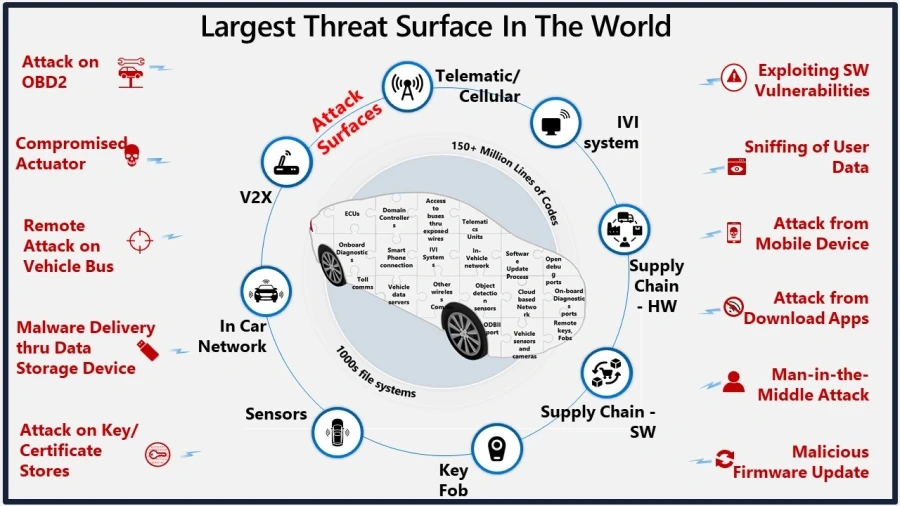
Source: Microsoft
AI-driven systems identify complex patterns, reduce false alerts, and respond to threats in real time. For example, Secure-IC’s AI-powered IDS system, Securyzr, identifies threats and provides instantaneous threat identification and mitigation directly at the edge.
Remote cyberattacks accounted for approximately 85% of automotive cyber incidents. This further increases the demand for real-time AI-driven detection and response mechanisms.
Key Benefits
- Intrusion Detection Systems – AI-driven intrusion detection systems continuously monitor in-vehicle networks and OT environments to identify anomalies. It prevents unauthorized access and ensures vehicle safety.
- Rapid Threat Analysis – The technology accelerates threat analysis and enables quick identification and mitigation of vulnerabilities within vehicle systems and OT infrastructures.
- Adaptive Security Protocols – AI facilitates the development of adaptive security protocols to ensure robust protection for vehicle communication networks and OT systems against sophisticated cyberattacks.
Popular Companies and Tools
PlaxidityX’s In-Vehicle Infotainment (IVI) Cybersecurity Solutions
PlaxidityX provides DevSecOps, vehicle protection, and fleet protection technologies. Its solutions ensure that vehicle components, networks, and fleets are secured and compliant throughout their lifecycle. PlaxidityX’s cybersecurity capabilities are integrated with Vodafone’s anti-theft and after-theft solutions to protect vehicles against sophisticated cyber threats.
Spotlighting an Innovator: Exein
Exein is an Italian startup that offers embedded cybersecurity solutions for Internet of Things (IoT) devices. Its technology integrates directly into device firmware to monitor system activities in real time. It also detects and isolates suspicious behaviors.
The technology protects connected vehicles by integrating embedded security measures that detect anomalies in vehicle communications. Exein’s solutions ensure efficient operations even on resource-constrained devices. The technology also offers on-device threat monitoring without relying on internet connectivity.
9. Research and development
Integrating gen AI in the automotive R&D process reduces costs, accelerates time to market, and improves quality. A McKinsey survey reveals that 75% of automotive companies experiment with at least one gen AI application, with over 40% investing up to GBP 5 million.
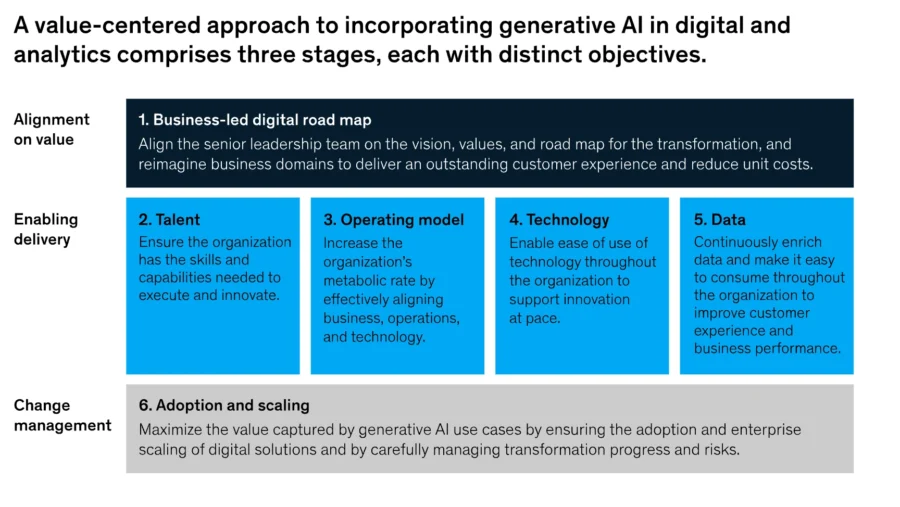
Source: McKinsey
AI accelerates vehicle design and prototyping as well as optimizes aerodynamics and performance. Researchers at the Massachusetts Institute of Technology (MIT) developed AI-driven design generation software, DrivAerNet++, that utilizes a dataset of over 8000 3D car models from brands, like BMW and Audi, to evaluate new car designs.
AI is integrated into testing and validation processes for cost-effective evaluation in research and development. For instance, Nio partners with Monolith to implement real-time AI in EV battery testing. This saves time and expedites the assessment process.
Further, Tesla leverages AI-powered “Fleet learning” technology to collect and analyze data from millions of vehicles to refine the autopilot system.
Key Benefits
- Accelerated Prototyping – AI-driven simulations and generative design algorithms enable rapid iteration of vehicle prototypes and reduce development time and costs.
- Optimized Component Design – Artificial intelligence processes vast datasets to enhance component performance. This leads to lighter, more efficient, and cost-effective vehicle parts.
- Enhanced Testing & Validation – AI facilitates virtual testing environments that allow designers to assess vehicle systems under various conditions.
Popular Companies and Tools
Ansys
Ansys integrates AI into its simulation software to accelerate design processes and improve accuracy. By applying deep learning techniques, Ansys addresses high-dimensional problems in simulation. This also reduces the time required for complex analyses from several days to minutes.
AVL
AVL offers AI-driven simulation solutions that virtualize vehicle functions to streamline development processes. Its tools enable precise predictions of vehicle behavior that facilitate efficient testing and validation. By incorporating AI, AVL improves the accuracy of simulations reduces the need for physical prototypes, and accelerates time-to-market for new automotive technologies.
Kia’s Exploration of Generative AI
Kia‘s global design team utilizes generative AI to revolutionize automotive design. By leveraging AI, Kia enhances creativity and efficiency in the design process for the exploration of innovative vehicle aesthetics and functionalities. This approach signifies a shift towards integrating advanced technologies to meet evolving consumer preferences and sustainability goals.
Spotlighting an Innovator: Automotive Artificial Intelligence
Automotive Artificial Intelligence (AAI) is a German company that develops the AAI ReplicaR platform, an intelligent simulation environment for autonomous driving software.
This platform enables vehicles to undergo extensive virtual testing by simulating programmable traffic scenarios and road conditions based on high-definition street maps.
A virtual vehicle can traverse distances in eight hours which would take over a month in real-world testing. AAI offers precise reproducibility of incidents and customizable test configurations to develop autonomous driving technologies.
10. Environmental and Sustainability Management
AI allows automobile companies to make environmentally conscious decisions by improving fuel efficiency and reducing emissions. It streamlines operations for substantial energy savings.
AI analytics improves energy efficiency in manufacturing by integrating technology to monitor and optimize energy consumption. Renault, for instance, has achieved a 25% reduction in energy consumption using AI and energy monitoring.
Integration of AI also accelerates significant investments directed toward AI-driven sustainability initiatives. Jaguar Land Rover, for example, invested approximately USD 654 million to upgrade its Halewood plant.
The plant has transformed into an all-electric facility equipped with AI-powered autonomous driving capabilities. This resulted in a daily reduction of 2.4 tonnes of CO2 and an annual saving of 565 tonnes.
Key Benefits
- Real-Time Emissions Monitoring – The technology analyzes data from vehicle sensors to monitor emissions in real time. It enables immediate identification of excessive pollutants and ensures compliance with environmental regulations.
- Resource Optimization – Artificial Intelligence optimizes energy consumption and material usage in manufacturing to reduce waste and the carbon footprint.
- Lifecycle Impact Assessment – AI evaluates environmental impacts across a vehicle’s lifecycle, from production to disposal, and supports the development of more sustainable automotive technologies.
Popular Companies and Tools
Prewave
Prewave utilizes AI to monitor and analyze supplier-related data from publicly available sources in over 50 languages. It identifies sustainability risks such as environmental pollution, human rights abuses, and corruption early in the supply chain. This proactive approach enables automotive manufacturers like Porsche, Audi, and Volkswagen to address potential issues promptly and ensure compliance with sustainability standards.
Audax Labs
Audax Labs integrates generative AI, connected vehicle technology, digital twins, augmented reality, and the IoT to promote sustainable innovation in the automotive sector. By employing generative AI, they optimize vehicle design for fuel efficiency and reduced emissions. Its connected vehicle solutions offer real-time diagnostics and vehicle-to-everything (V2X) communication to enhance energy efficiency. Additionally, digital twin technology ensures precise monitoring and simulation to reduce waste and improve manufacturing.
Spotlighting an Innovator: TWAICE
TWAICE is a German startup that offers a battery analytics platform. The platform converts battery data into actionable insights throughout the battery lifecycle. TWAICE’s platform integrates deep battery knowledge with artificial intelligence to monitor battery health, predict performance issues, and optimize maintenance strategies.
The platform also enhances battery performance, safety, and longevity to reduce operational costs and improve efficiency. TWAICE provides deep insights into battery performance and maximizes the value and reliability of battery-dependent operations.

Key Drivers Behind the Adoption of AI in Automotive
Transition to Electric and Autonomous Vehicles
AI optimizes performance and safety in EVs. Tesla and Waymo utilize AI for perception, planning, and decision-making. Such algorithms streamline R&D for EVs by minimizing the design and development time and optimizing vehicle components for better aerodynamics.
Automotive companies are heavily leveraging AI to enable vehicles to navigate complex environments and detect obstacles. The technology also analyzes data from vehicle sensors and manages energy consumption efficiently by optimizing battery usage. The momentum behind this technology is significant as there could be 3.5 million self-driving vehicles on US roads by 2025 and 4.5 million by 2030.
The progression toward autonomous driving is also accelerating, with projections indicating that by 2030, approximately 40% of new cars sold will feature Level 3 autonomy or higher.
Technological Advancements and Software Integrations
AI-powered voice assistants, such as those developed by Cerence, enable drivers to control various in-vehicle functions through natural speech commands. Similarly, Smart Eye offers AI-driven driver monitoring systems to assess driver attentiveness and detect signs of distraction or fatigue.
AI enables ADAS to encompass features like adaptive cruise control, lane-keeping assistance, and collision avoidance. These systems rely on AI to process data from sensors such as cameras, radar, and ultrasonic sensors.
Moreover, the advent of Level 2+ vehicles integrates surround perception and AI technologies to bolster safety and convenience. These vehicles incorporate features like driver monitoring and AI co-pilot functionalities to create a more intuitive and responsive driving environment.
Market Competition and Strategic Advantage
75% of automakers plan to integrate generative AI into vehicles within the year. Companies like BYD are setting new industry precedents by making ADAS a standard feature across most of their models at no additional cost.
The potential of artificial intelligence in manufacturing processes is highlighted by Audi, which utilizes AI to detect minute cracks in sheet metal to ensure higher product quality. Moreover, the technology is employed by General Motors for product prototyping and accelerating development cycles.
Future of AI in the Automotive Industry: 3 Emerging Trends
Emotion-Responsive AI Systems
AI is employed to analyze drivers’ facial expressions, voice tones, and other biometric data to assess their emotional states. For instance, Affectiva’s Emotion AI technology detects emotions by interpreting facial cues and vocal intonations.
By understanding driver emotions, AI adjusts in-cabin settings like music, lighting, or climate control, as well as enhances comfort and safety. This personalized approach creates a more intuitive and responsive driving experience.
Multimodal AI for Enhanced Decision-Making
Advanced artificial intelligence systems process data from various sensors simultaneously – like cameras, LIDAR, and microphones. This enables vehicles to better understand their surroundings and make more informed decisions.
Enhanced situational awareness will improve autonomous driving capabilities, leading to safer and more reliable self-driving vehicles.
AI-Powered V2X Communication
AI enhances V2X systems by predicting traffic patterns and facilitating real-time communication between vehicles and infrastructure. This enables vehicles to respond intelligently to dynamic traffic conditions.
Improved traffic flow, reduced congestion, and road safety are anticipated as vehicles become more adept at interacting with their environment.
Finding the Best AI Solutions for Your Automotive Company
With thousands of emerging AI technologies and startups, navigating the right investment and partnership opportunities is challenging.
With access to over 5 million emerging companies and 20K+ technologies & trends globally, our AI and Big Data-powered Discovery Platform equips you with the actionable insights you need to stay ahead of the curve.
Leverage this powerful tool to spot the next big thing in AI before it goes mainstream. Stay relevant, resilient, and ready for what is next.

![AI in Automotive: A Strategic Guide for Industry Leaders [2025-2030]](https://www.startus-insights.com/wp-content/uploads/2025/03/AI-in-Automotive-SharedImg-StartUs-Insights-noresize-420x236.webp)

